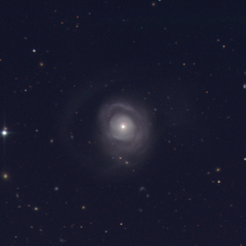Swiftly moving gas streamer eclipses supermassive black hole
This discovery was accomplished through an intensive observing campaign with the major ESA and NASA space observatories: XMM-Newton, the Hubble Space Telescope, Swift, NuSTAR, Chandra, and INTEGRAL. MPE researchers Gabriele Ponti, Barbara De Marco and Kirpal Nandra were part of the international team conducting the most extensive monitoring campaign ever of an active galaxy in 2013 and 2014.

“The active galaxy NGC 5548 has been studied for decades, but this was the first time that we have seen such a long-lived clumpy stream of ionized gas,” explains Ponti. “Using six observatories, we were able to study how these winds appear at different wavelengths. Linking the obscured X-rays and the simultaneous deep, broad UV absorption troughs enabled us to make an important step forward in our understanding of the winds from accreting black holes.”
Matter falling onto a black hole gets heated and emits X-rays and ultraviolet radiation. The ultraviolet radiation can launch winds outward. The winds may be so strong that they can blow off gas that otherwise would have fallen onto the black hole.
The winds in AGN come more easily into existence if their starting point is shielded from X-rays. The newly discovered gas stream in the Seyfert galaxy NGC 5548 provides this protection, blocking 90% of the soft X-ray emission.
It appears that the shielding has been going on for at least three years and because of this shielding, the persistent wind far away from the nucleus receives less radiation and cools down. “This discovery highlights how important these obscuring streams of gas can be for reshaping the appearance of standard active galaxies on time scales of years,” says Barbara De Marco, who is analysing the time variability of the event.
Although the outflow in NGC 5548 is not strong enough to influence its host galaxy far away from the supermassive black hole at its centre, it gives the researchers unique insight into how the same mechanism may be at work in much more powerful quasars.
An animated journey through the active galaxy NGC 5548.
At the centre of NGC 5548 is a supermassive black hole that is 40 million times heavier than our Sun, all concentrated in a region smaller than the Earth’s orbit around the Sun. Gas swirls around this black hole and is sucked into it, heating up its surroundings and producing strong energetic X-ray radiation. This X-ray hot corona is fuelled through a rapidly rotating accretion disk. The disk also produces strong patchy winds of warm gas that is thrown out into space. It contains denser parts that may obscure the X-rays emitted in the direction towards the Earth, shown by the green line.
The power emitted by the nucleus is so strong that it affects major parts of the host galaxy. The galaxy has a size of hundred thousand light years and is at a distance of 240 million light years away from us.
Further information
Team:
The team consists of Jelle Kaastra (SRON Utrecht, The Netherlands), Jerry Kriss (Space Telescope Science Institute, Baltimore, USA), Massimo Cappi (INAF-IASF Bologna, Italy), Missagh Mehdipour (SRON Utrecht, The Netherlands), Pierre-Olivier Petrucci (Univ. Grenoble Alpes, CNRS, France), Katrien Steenbrugge (Universidad Católica del Norte, Antofagasta, Chile), Nahum Arav (Virginia Tech, Blacksburg, USA), Ehud Behar (Technion-Israel Institute of Technology, Haifa, Israel), Stefano Bianchi (Università degli Studi Roma Tre, Italy), Rozenn Boissay (University of Geneva , Switzerland), Graziella Branduardi-Raymont (MSSL/UCL, Holmbury St. Mary, UK), Carter Chamberlain (Virginia Tech, Blacksburg, USA ), Elisa Costantini (SRON Utrecht, The Netherlands), Justin Ely (Space Telescope Science Institute, Baltimore, USA), Jacobo Ebrero (ESA, Spain), Laura Di Gesu (SRON Utrecht, The Netherlands), Fiona Harrison (California Institute of Technology, Pasadena, USA), Shai Kaspi (Technion-Israel Institute of Technology, Haifa, Israel), Julien Malzac (Université de Toulouse, France), Barbara De Marco (Max-Planck-Institut für extraterrestrische Physik, Garching, Germany), Giorgio Matt (Università degli Studi Roma Tre, Italy), Paul Nandra (Max-Planck-Institut für extraterrestrische Physik, Garching, Germany), Stéphane Paltani (University of Geneva , Switzerland), Renaud Person (St. Jorioz, France), Brad Peterson (Ohio State University, Columbus, USA), Ciro Pinto (University of Cambridge, UK), Gabriele Ponti (Max-Planck-Institut für extraterrestrische Physik, Garching, Germany), Francisco Pozo Nuñez (Ruhr-Universität Bochum, Germany), Alessandra De Rosa (INAF/IAPS, Roma, Italy), Hiromi Seta (Rikkyo University, Tokyo, Japan), Francesco Ursini (University of Grenoble, CNRS, France), Cor de Vries (SRON Utrecht, The Netherlands), Dom Walton (California Institute of Technology, Pasadena, USA), Megan Whewell (MSSL/UCL, Holmbury St. Mary, UK).
MPE contribution :
Researchers at MPE were on the front line, in the monitoring of the event as it was unfolding over summer 2013, triggering further observations that were important for the final understanding of the phenomenon. Currently MPE is leading the variability (X-ray timing) studies within the collaboration and,
together with INAF-Bologna, MPE is responsible for the data reduction and analysis of the data from the EPIC-cameras aboard XMM-Newton and has contributed 125ks of observing time with the LETG instrument aboard the Chandra satellite.












